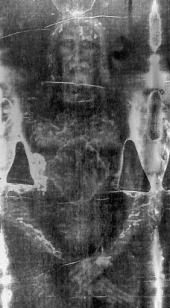The shroud we are familiar with today first showed up in the small village of Lirey, France around 1360 A.D. It then was transferred to Chambery around 1453. In 1532, the chapel housing the relic caught on fire and damaged the linen. In 1578, the shroud was moved to the northern Italian city of Turin.
The Catholic Church stops short of officially declaring the shroud of Turin to be the burial cloth of Christ. However, in their official 1913 Encyclopedia article on the relic, they state, "That the authenticity of the Shroud . . . is taken for granted, in various pronouncements of the Holy See, cannot be disputed." A 1506 Papal Bull by Pope Julius II says that the cloth was used to wrap Jesus as he lay in his tomb.
In June 2015, Pope Francis visited the city of Turin to view the shroud. News agencies reported that he made a special pilgrimage to the place housing the relic and, bowing his head, silently prayed in front of it. Clearly, regardless of any official stance, the church treats this relic as if it were legitimate.

There are several major arguments that not only refute any claims the shroud is legitimate but also condemn how it is used. Scripture, for example, indicates that the body of Christ was not wrapped in one cloth from head to toe as is portrayed in the clothe. His body was wrapped with one piece of cloth and his head with a separate piece (John 20:5 - 7).
The shroud of Turin shows the image of a man wearing long hair. This could not have been Jesus as the Bible clearly states that it is a shame for a man serving the true God to wear long hair (see 1Corinthians 11:14, 16). Only those who took a Nazarite vow, like John the Baptist, could wear uncut hair (Numbers 6:2 - 21). Jesus was not a Nazarite, as He drank alcoholic beverages and touched dead bodies (Luke 7:11 - 15, 8:49 - 55, see our article on Nazarites).
Catholics, in their 1913 Encyclopedia, honestly admit that the history of the relic can only be traced back to around 1360 A.D. (article "The Holy Shroud of Turin")! In a Catholic approved book titled "Relics" it states, "Its existence before then (before the 14th century) is not definitely recorded . . ." (Relics, Joan Carrol Cruz, page 46). How could the most widely known relic in Christendom just "pop up" more than thirteen centuries after Christ’s death?
The second of the Ten Commandments states that humans are not to make any idols, for the purpose of worship, representing anything He has created (Exodus 20:4 - 5). The intent of the commandment is to prohibit the use of images, icons and relics (e.g. the linen at Turin) as an aid to worshipping the true God, as most Biblical commentaries (e.g. Hodge's Systematic Theology, Fausset's Bible Dictionary, etc.) agree.
Many religious people treat this cloth as far more than just a curiosity. Again, the Catholic Encyclopedia admits that since 1578 it has been "exposed for veneration at long intervals." To venerate something is to revere or worship it. Clearly, the shroud of Turin is treated by many people as worthy of religious adoration that God says belongs to him alone. It is a relic that should be destroyed.